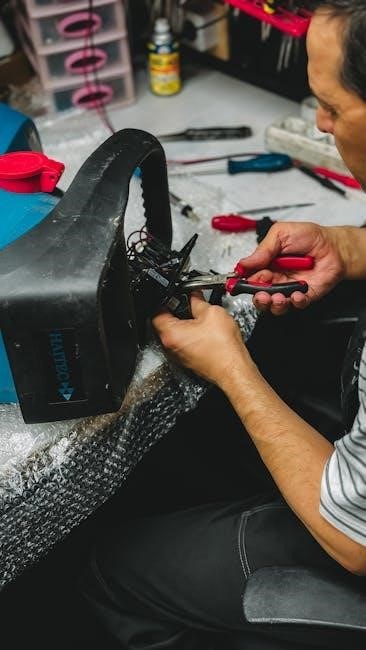Definition and Purpose
A manual call point (MCP) is a device in fire alarm systems, enabling individuals to trigger alarms manually. Its primary purpose is to initiate rapid emergency responses.
1.1 What is a Manual Call Point (MCP)?
A Manual Call Point (MCP) is an electromechanical device used in fire detection systems. It allows individuals to manually activate a fire alarm, typically by breaking glass or pressing a button, ensuring rapid response in emergency situations. These devices are essential components of fire safety systems, enabling quick initiation of alarms.
1.2 Primary Function in Fire Safety Systems
The primary function of a Manual Call Point (MCP) is to enable individuals to manually initiate a fire alarm, ensuring rapid notification of emergencies. By breaking glass or pressing a button, it activates the fire alarm system, alerting occupants and emergency services, thus playing a critical role in fire safety protocols.
Types of Manual Call Points
Manual Call Points are primarily categorized into break glass and push button types, each designed for quick activation in emergencies, ensuring reliable fire alarm initiation.
2.1 Break Glass Call Points
Break glass call points are activated by shattering glass, triggering an alarm. They feature a spring mechanism, ensuring immediate activation. Designed for emergency situations, they are typically red, comply with standards like BS EN 54-11, and are installed in zones requiring rapid response, such as industrial or high-risk areas.
2.2 Push Button Call Points
Push button call points are simple, durable devices activated by pressing a button, initiating a fire alarm. They are easy to use, reducing accidental activation. Designed with a compact, red housing, they are ideal for high-traffic areas like commercial buildings and public spaces, meeting fire safety standards and ensuring quick emergency responses.

Technical Specifications
Manual call points meet BS EN 54-11 standards, typically measuring 95 mm x 98 mm x 76 mm, with durable aluminum housings ensuring reliability and compliance in fire systems;
3.1 Size and Dimensions
Manual call points typically measure 95 mm x 98 mm x 76 mm, ensuring a compact design for easy installation. Their standardized size allows uniformity across fire safety systems, meeting regulatory requirements and facilitating seamless integration into various environments while maintaining accessibility and visibility.
3.2 Housing Material and Color
Manual call points typically feature durable aluminum housing, ensuring robustness and resistance to environmental factors. The units are usually colored red, a universally recognized color for emergency devices, enhancing visibility and quick identification in critical situations. This standardized color and material design ensures consistency and compliance with fire safety regulations.
3.4 Operating Mechanism (Spring or Lever)
Manual call points operate via a spring or lever mechanism. Spring-loaded units automatically reset after activation, while lever models require manual resetting. Both mechanisms ensure reliable activation, providing a straightforward and efficient way to trigger fire alarms in emergency situations. The design ensures durability and consistent performance across various environments.

Components of a Manual Call Point
A manual call point consists of an activation mechanism, electrical wiring, and end-of-line resistors. These components ensure reliable operation and integration with fire alarm systems effectively.
4.1 Manual Activation Mechanism
The manual activation mechanism is a critical component, typically a break-glass or push-button system, designed to enable quick and reliable initiation of a fire alarm during emergencies. It ensures easy operation, allowing individuals to trigger the alarm swiftly by breaking glass or pressing a button, thereby activating the fire safety response system effectively.
4.2 Electrical Wiring and Connectors
Electrical wiring and connectors are vital for the reliable operation of manual call points. They must comply with international standards such as BS EN 54-11 and NPB 70-98. Secure, durable connectors ensure consistent signal transmission, while heat-resistant and fire-resistant wiring guarantees uninterrupted communication during emergencies. Proper installation and testing are essential for system performance and safety.
4.3 End-of-Line (EOL) Resistors
End-of-Line (EOL) resistors are critical components in manual call point circuits. They ensure proper signal termination, preventing false alarms and detecting wiring faults. EOL resistors are installed at the end of each zone’s wiring to maintain circuit integrity and comply with fire safety standards like BS EN 54-11 for reliable system operation.
Installation Guidelines
Manual call points are typically installed in fire-prone areas such as kitchens and near exits. They should be mounted at a standard height for easy access and comply with local fire safety regulations to ensure effective emergency response.
5.1 Recommended Zones for Installation
Manual call points should be installed in high-risk areas such as commercial kitchens, industrial facilities, and public spaces. Zones like Zone 1 (high-hazard areas) and Zone 2 (general spaces) are ideal. They are also suitable for Zone 21 (dust-risk areas) and Zone 22 (high-humidity environments), ensuring comprehensive fire safety coverage.
5.2 Placement and AccessibilityRequirements
5.2 Placement and Accessibility Requirements
Manual call points must be installed at a height of 1.5 meters from the floor for easy accessibility. They should be placed along escape routes, in high-traffic areas, and near exits. Ensure visibility and avoid obstructions. Compliance with standards like BS EN 54-11 guarantees proper placement for effective emergency response.
5.3 Compliance with Fire Safety Standards
Manual call points must comply with fire safety standards like BS EN 54-11 and NPB 70-98. These standards ensure proper design, installation, and functionality. Compliance guarantees reliability, durability, and effective integration with fire alarm systems, meeting legal and safety requirements for emergency response in various environments.

Integration with Fire Alarm Systems
Manual call points integrate seamlessly with fire alarm panels, enabling immediate activation of alarms. They are essential components of fire detection systems, ensuring rapid response to emergencies.
6.1 Connection to Fire Alarm Panels
Manual call points connect to fire alarm panels via electrical wiring, ensuring reliable communication. End-of-line resistors monitor circuit integrity, detecting faults like open or short circuits, critical for system reliability.
6.2 Role in Fire Detection and Alarm Systems
Manual call points serve as critical interfaces for initiating fire alarms in detection systems. They enable rapid, manual activation, ensuring timely alerts and emergency responses. MCPs integrate seamlessly with fire alarm panels, providing precise location identification and enhancing the overall effectiveness of fire detection and alarm systems in safeguarding life and property.
6.3 Interaction with Other Safety Devices
Manual call points integrate with fire alarm panels, smoke detectors, and other safety devices to enhance system functionality. They trigger alarms, activate sprinklers, and coordinate with emergency lighting, ensuring a unified response. This interaction streamlines emergency operations, improving safety and efficiency in fire scenarios.
Applications and Use Cases
Manual call points are essential in commercial buildings, industrial facilities, and public areas with high foot traffic, enabling quick fire alarm activation to protect lives and property.
7.1 Commercial Buildings
Manual call points are crucial in commercial buildings, such as offices, malls, and hotels, to enable quick fire alarm activation. They are typically installed near exits or high-traffic areas, ensuring visibility and accessibility. Their presence ensures rapid emergency response, protecting occupants and assets while complying with fire safety regulations like BS EN 54-11.
7.2 Industrial Facilities
Manual call points are essential in industrial facilities to quickly alert personnel and emergency services of fires. They are typically placed near exits or in high-risk areas, ensuring rapid evacuation and response. Their installation is crucial for safeguarding lives and assets in industrial environments, complying with fire safety regulations like BS EN 54-11.
7.3 Public and High-Traffic Areas
Manual call points are critical in public spaces like malls, stadiums, and train stations, where rapid fire detection is vital. They are installed at accessible heights near exits and escape routes, ensuring visibility and ease of use. Their presence in high-traffic areas ensures quick activation of fire alarms, minimizing risks and protecting large crowds.

Standards and Regulations
Manual call points must comply with BS EN 54-11 and NPB 70-98, ensuring reliability and proper integration into fire alarm systems through rigorous testing and adherence to international standards.
8.1 BS EN 54-11 Compliance
BS EN 54-11 outlines technical requirements for manual call points, ensuring reliable operation in fire alarm systems. It specifies testing methods, operational requirements, and durability standards, guaranteeing devices activate alarms effectively and consistently in emergency situations.
8.2 NPB 70-98 Requirements
NPB 70-98 specifies requirements for manual call points, including design, testing, and installation. It ensures devices meet durability, environmental resistance, and operational standards, critical for reliable performance in fire safety systems. Compliance with these standards guarantees effective activation of fire alarms in emergency situations, aligning with Russian fire safety regulations.
8.3 Other Relevant International Standards
Manual call points must comply with international standards like ISO 7240-1, which outlines requirements for fire alarm systems. These standards ensure devices meet global safety, design, and performance criteria. Compliance guarantees reliability and proper integration with fire safety systems worldwide, addressing durability and operational effectiveness in diverse environments.
Maintenance and Testing
Manual call points require regular inspections, functional testing, and maintenance to ensure reliability. This includes checking wiring, mechanisms, and ensuring compliance with fire safety standards.
9.1 Regular Inspection Requirements
Manual call points must undergo regular inspections to ensure proper functionality. This includes checking for damage, wear, and tear, as well as verifying that all components operate correctly. Inspections should be conducted by trained personnel, with frequency defined by local fire safety regulations to maintain system reliability and user safety.
9.2 Testing Methods and Frequencies
Manual call points should be tested quarterly or annually, depending on local regulations. Testing involves activating the device to ensure proper alarm initiation and system response. Visual inspections and functional tests verify wiring integrity, button or glass operation, and correct signaling to the fire alarm panel, ensuring compliance with standards like NPB 70-98.
9.3 Troubleshooting Common Issues
Common issues with manual call points include faulty wiring, broken glass, or mechanical failures. Troubleshooting involves checking connections, testing activation, and inspecting for physical damage. Regular maintenance ensures reliability, while replacements are needed for irreversible damage. Compliance with standards like NPB 70-98 ensures proper diagnostic and repair procedures are followed effectively.

Safety Benefits
Manual call points provide immediate fire alarm activation, ensuring rapid response and evacuation. They enhance safety by allowing individuals to alert others quickly, preventing potential accidents and saving lives.
10.1 Rapid Fire Alarm Activation
Manual call points enable instant activation of fire alarms, ensuring quick notification of emergencies. This rapid response capability is crucial for timely evacuation and fire containment, enhancing overall safety and reducing potential risks in critical situations.
10.2 Enhanced Emergency Response
Manual call points enhance emergency response by providing immediate and precise location information. This allows emergency services to react swiftly and effectively, minimizing risks and improving outcomes. The clear identification of fire sources ensures targeted actions, optimizing resource allocation and response times.
10.3 Fail-Safe Mechanisms
Manual call points incorporate fail-safe mechanisms, such as spring-loaded glass breakers and redundant wiring, to ensure reliable activation even during system failures. These mechanisms guarantee alarm initiation, preventing critical delays. Durable materials and compliance with safety standards further enhance their dependability, ensuring consistent performance in emergency situations.

Common Misconceptions
Common misconceptions about Manual Call Points often involve their reliability, installation, and maintenance, which can lead to improper use and reduced effectiveness in emergencies.
11.1 Myths About Manual Call Point Reliability
Myths about Manual Call Point reliability often stem from misconceptions about their durability and effectiveness. Many believe MCPs are prone to false alarms or mechanical failures, but this is unfounded. Properly installed and maintained MCPs, compliant with standards like BS EN 54-11, are highly reliable and critical for timely emergency responses.
11.2 Misunderstandings About Installation
A common misunderstanding is that manual call points can be installed anywhere. However, they must be placed according to specific fire safety standards, ensuring accessibility and visibility. Incorrect installation can lead to reduced effectiveness or non-compliance with regulations like NPB 70-98, emphasizing proper zoning and placement requirements for optimal functionality.
11.3 False Perceptions of Durability
Some believe manual call points are virtually indestructible, requiring no maintenance. However, they must meet specific standards like BS EN 54-11 and NPB 70-98, and regular inspections are crucial to ensure functionality. While durable, they are not foolproof, and neglecting maintenance can lead to failures, highlighting the need for consistent upkeep.
Future Trends
Future trends involve integrating manual call points with smart fire systems, advancing MCP technology for better performance, and adopting wireless solutions to improve reliability and efficiency.
12.1 Integration with Smart Fire Safety Systems
Manual call points are increasingly being integrated with smart fire safety systems, enabling real-time monitoring, data analytics, and seamless connectivity with other safety devices. This integration enhances emergency response efficiency and ensures faster activation of alarms, improving overall fire safety management.
12.2 Advancements in Manual Call Point Technology
Advancements include wireless connectivity, reducing installation complexity, and smart technology enabling real-time monitoring. Improved materials enhance durability, and energy-efficient designs extend battery life. These innovations ensure reliability, faster response times, and better integration with modern fire safety systems, addressing evolving safety needs effectively.
12.3 Adoption of Wireless Call Points
Wireless call points offer enhanced flexibility and ease of installation, eliminating the need for complex wiring. They provide reliable communication with fire alarm systems, reducing installation costs and downtime. This technology supports seamless integration with existing infrastructure, ensuring rapid response capabilities while maintaining high standards of safety and system performance.
A manual call point is a critical component in fire safety, enabling rapid alarm activation and ensuring timely emergency responses. Its reliability and ease of use make it indispensable in protecting lives and property.
13.1 Summary of Key Points
A manual call point (MCP) is a vital fire safety device enabling individuals to trigger alarms manually. It serves as a critical component in fire detection systems, ensuring rapid emergency responses. MCPs are designed for reliability, durability, and ease of use, making them essential for protecting lives and property in various environments.
13.2 Importance in Modern Fire Safety
A manual call point is a crucial component in modern fire safety, enabling swift activation of alarms during emergencies. Its reliability ensures timely responses, protecting lives and property. Integration with advanced fire systems enhances functionality, making MCPs indispensable in maintaining safety standards across various environments and ensuring compliance with fire safety regulations.
